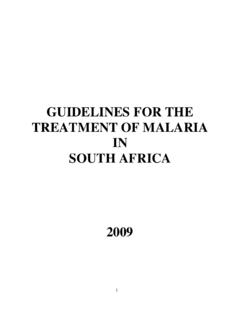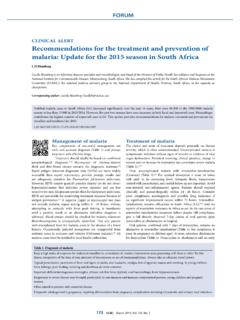Transcription of DATA SHEET MALARONE TABLETS and MALARONE JUNIOR …
1 1 data SHEET MALARONE TABLETS and MALARONE JUNIOR TABLETS Presentation MALARONE TABLETS are round, biconvex, pink film coated TABLETS , engraved on one side with GX CM3 . Each MALARONE tablet contains atovaquone 250mg and proguanil hydrochloride 100mg. Do not halve tablet. MALARONE JUNIOR TABLETS are round, biconvex, pink film coated TABLETS engraved on one side with GX CG7 . Each MALARONE JUNIOR tablet contains atovaquone and proguanil hydrochloride 25mg. Do not halve the tablet. Uses Actions Pharmacotherapeutic Group: Antimalarials.
2 The constituents of MALARONE , atovaquone and proguanil hydrochloride, interfere with two different pathways involved in the biosynthesis of pyrimidines required for nucleic acid replication. The mechanism of action of atovaquone against P. falciparum is via inhibition of mitochondrial electron transport, at the level of the cytochrome bc1 complex, and collapse of mitochondrial membrane potential. One mechanism of action of proguanil, via its metabolite cycloguanil, is inhibition of dihydrofolate reductase, which disrupts deoxythymidylate synthesis.
3 Proguanil also has antimalarial activity independent of its metabolism to cycloguanil, and proguanil, but not cycloguanil, is able to potentiate the ability of atovaquone to collapse mitochondrial membrane potential in malaria parasites. This latter mechanism may explain the synergy seen when atovaquone and proguanil are used in combination. Microbiology: Atovaquone has potent activity against Plasmodium spp (in vitro IC50 against P. falciparum ). The antimalarial activity of proguanil is exerted via the primary metabolite cycloguanil (in vitro IC50 against various P.)
4 Falciparum strains of 4-20ng/mL; some activity of proguanil and another metabolite, 4-chlorophenylbiguanide, is seen in vitro at 600-3000ng/mL). 2 In in vitro studies of P. falciparum the combination of atovaquone and proguanil was shown to be synergistic. This enhanced efficacy was also demonstrated in clinical studies. Pharmacokinetics There are no pharmacokinetic interactions between atovaquone and proguanil at the recommended dose. In clinical trials, trough levels of atovaquone, proguanil and cycloguanil in children (weighing 5-40kg) are within the effective range observed in adults after adjusting for bodyweight.
5 Absorption: Atovaquone is a highly lipophilic compound with low aqueous solubility. The pharmacokinetics of atovaquone are comparable between healthy subjects and HIV-infected patients. Although there are no atovaquone biovabilability data in healthy subjects, in HIV-infected patients the absolute bioavailability of a 750mg single dose of atovaquone TABLETS taken with food is 21% (90%CI: 17% - 27%). Dietary fat taken with atovaquone increases the rate and extent of absorption, increasing AUC 2-3 times and Cmax 5 times over fasting.
6 Patients are recommended to take MALARONE TABLETS with food or a milky drink. (see Dosage and Administration). Proguanil hydrochloride is rapidly and extensively absorbed regardless of food intake. Distribution: Apparent volume of distribution of atovaquone and proguanil is a function of body weight. Atovaquone is highly protein bound (> 99%) but does not displace other highly protein bound medicines in vitro, indicating significant drug interactions arising from displacement are unlikely. Following oral administration, the volume of distribution of atovaquone in adults and children is approximately Proguanil is 75% protein bound.
7 Following oral administration, the volume of distribution of proguanil in adults weighing 41 to 80kg is 42 to 27L/kg. The volume of distribution is approximately 42 to 20L/kg in children weighing 11 to 40kg, and is 79 to 45L/kg in children weighing 5 to 10kg. In human plasma the binding of atovaquone and proguanil were unaffected by the presence of the other. Metabolism: There is no evidence that atovaquone is metabolised and there is negligible excretion of atovaquone in urine with the parent compound being predominantly (> 90%) eliminated unchanged in faeces.
8 3 Proguanil hydrochloride is partially metabolised with less than 40% being excreted unchanged in the urine. Its metabolites, cycloguanil and 4- chlorophenylbiguanide, are also excreted in the urine. During administration of MALARONE at recommended doses proguanil metabolism status appears to have no implications for treatment or prophylaxis of malaria. Elimination: The elimination half life of atovaquone is about 2-3 days in adults and 1-2 days in children. Oral clearance ot atovaquone and proguanil is a function of body weight.
9 Following oral administration, the clearance of atovaquone in adults and children weighing 41 to 80kg is approximately to The clearance is approximately in children weighing 11 to 40kg, respectively and to in children weighing 5 to 10kg. Following oral administration, the clearance of proguanil in adults weighing 41 to 80kg is The clearance is approximately in children weighing 5 to 10kg. The elimination half life of proguanil and cycloguanil is about 12-15 hours in both adults and children. Pharmacokinetics in the elderly: There is no clinically significant change in the average rate or extent of absorption of atovaquone or proguanil between elderly and young patients.
10 Systemic availability of cycloguanil is higher in the elderly compared to the young patients, but there is no clinically significant change in its elimination half-life (see Dosage and Administration). Pharmacokinetics in hepatic impairment: In patients with mild to moderate hepatic impairment there is no clinically significant change in exposure to atovaquone when compared to healthy patients. In patients with mild to moderate hepatic impairment there is an increase in proguanil AUC with no change in its elimination half life and there is a decrease in Cmax and AUC for cycloguanil.













